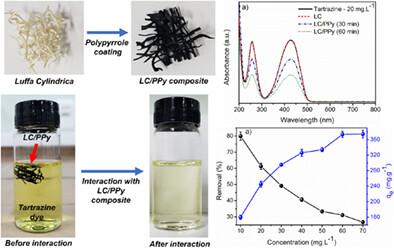Maurício F. de Aguiar, Andressa N. R. Leal, Joyce Silva, Gizele G. F. de Andrade, Celso P. de Melo, Kleber G. B. Alves
求助PDF
{"title":"丝瓜/聚吡咯复合材料去除水中染料的研究","authors":"Maurício F. de Aguiar, Andressa N. R. Leal, Joyce Silva, Gizele G. F. de Andrade, Celso P. de Melo, Kleber G. B. Alves","doi":"10.1002/pi.6563","DOIUrl":null,"url":null,"abstract":"<p>We report the preparation of a <i>Luffa cylindrica</i>/polypyrrole (LC/PPy) composite and its use for the removal of tartrazine dye (E102) from aqueous media. By use of Fourier transform infrared (FTIR) and energy-dispersive X-ray (EDX) spectroscopies, X-ray diffraction (XRD) and scanning electron microscopy (SEM), we were able to confirm that the PPy chains thoroughly coat the LC matrix, with the composite presenting both amorphous and crystalline phases such as pristine LC. We examined the effects of varying parameters, such as the times allotted for the polymerization and the dye–adsorbent interaction, the E102 initial concentration and the temperature and pH of the solution, on the removal capacity (<i>q</i><sub>e</sub>) of the composite. The largest adsorption rate was exhibited by the composite resulting from a 30 min polymerization. At 298 K, the highest value of <i>q</i><sub>e</sub> (374.2 mg g<sup>−1</sup>) occurred at pH 2.0, after 360 min of interaction. The adsorption process occurs spontaneously and is favored by an increase in temperature, with <i>q</i><sub>e</sub> = 672.4 mg g<sup>−1</sup> at 313 K. We determined that the composite could be used in at least five consecutive adsorption–desorption cycles without noticeable losses of properties. Preliminary experiments indicate that good results were also obtained for the removal of the dyes Remazol Black B, methylene blue and toluidine blue. Overall, these results suggest that the LC/PPy composite is a promising material for use in protocols of removal of dyes from aqueous media. © 2023 Society of Industrial Chemistry.</p>","PeriodicalId":20404,"journal":{"name":"Polymer International","volume":"72 12","pages":"1112-1121"},"PeriodicalIF":2.9000,"publicationDate":"2023-07-15","publicationTypes":"Journal Article","fieldsOfStudy":null,"isOpenAccess":false,"openAccessPdf":"","citationCount":"0","resultStr":"{\"title\":\"Use of a Luffa cylindrica/polypyrrole composite for removing dyes from aqueous media\",\"authors\":\"Maurício F. de Aguiar, Andressa N. R. Leal, Joyce Silva, Gizele G. F. de Andrade, Celso P. de Melo, Kleber G. B. Alves\",\"doi\":\"10.1002/pi.6563\",\"DOIUrl\":null,\"url\":null,\"abstract\":\"<p>We report the preparation of a <i>Luffa cylindrica</i>/polypyrrole (LC/PPy) composite and its use for the removal of tartrazine dye (E102) from aqueous media. By use of Fourier transform infrared (FTIR) and energy-dispersive X-ray (EDX) spectroscopies, X-ray diffraction (XRD) and scanning electron microscopy (SEM), we were able to confirm that the PPy chains thoroughly coat the LC matrix, with the composite presenting both amorphous and crystalline phases such as pristine LC. We examined the effects of varying parameters, such as the times allotted for the polymerization and the dye–adsorbent interaction, the E102 initial concentration and the temperature and pH of the solution, on the removal capacity (<i>q</i><sub>e</sub>) of the composite. The largest adsorption rate was exhibited by the composite resulting from a 30 min polymerization. At 298 K, the highest value of <i>q</i><sub>e</sub> (374.2 mg g<sup>−1</sup>) occurred at pH 2.0, after 360 min of interaction. The adsorption process occurs spontaneously and is favored by an increase in temperature, with <i>q</i><sub>e</sub> = 672.4 mg g<sup>−1</sup> at 313 K. We determined that the composite could be used in at least five consecutive adsorption–desorption cycles without noticeable losses of properties. Preliminary experiments indicate that good results were also obtained for the removal of the dyes Remazol Black B, methylene blue and toluidine blue. Overall, these results suggest that the LC/PPy composite is a promising material for use in protocols of removal of dyes from aqueous media. © 2023 Society of Industrial Chemistry.</p>\",\"PeriodicalId\":20404,\"journal\":{\"name\":\"Polymer International\",\"volume\":\"72 12\",\"pages\":\"1112-1121\"},\"PeriodicalIF\":2.9000,\"publicationDate\":\"2023-07-15\",\"publicationTypes\":\"Journal Article\",\"fieldsOfStudy\":null,\"isOpenAccess\":false,\"openAccessPdf\":\"\",\"citationCount\":\"0\",\"resultStr\":null,\"platform\":\"Semanticscholar\",\"paperid\":null,\"PeriodicalName\":\"Polymer International\",\"FirstCategoryId\":\"92\",\"ListUrlMain\":\"https://onlinelibrary.wiley.com/doi/10.1002/pi.6563\",\"RegionNum\":4,\"RegionCategory\":\"化学\",\"ArticlePicture\":[],\"TitleCN\":null,\"AbstractTextCN\":null,\"PMCID\":null,\"EPubDate\":\"\",\"PubModel\":\"\",\"JCR\":\"Q2\",\"JCRName\":\"POLYMER SCIENCE\",\"Score\":null,\"Total\":0}","platform":"Semanticscholar","paperid":null,"PeriodicalName":"Polymer International","FirstCategoryId":"92","ListUrlMain":"https://onlinelibrary.wiley.com/doi/10.1002/pi.6563","RegionNum":4,"RegionCategory":"化学","ArticlePicture":[],"TitleCN":null,"AbstractTextCN":null,"PMCID":null,"EPubDate":"","PubModel":"","JCR":"Q2","JCRName":"POLYMER SCIENCE","Score":null,"Total":0}
引用次数: 0
引用
批量引用


 求助内容:
求助内容: 应助结果提醒方式:
应助结果提醒方式:


